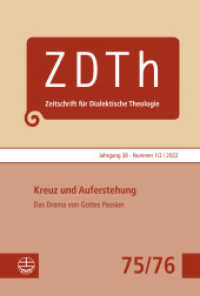Full Description
When the Nazis started to threaten the world with their efficient machine of propaganda, the main concern of European governments was the overwhelming reaction of panic that the expected bombing of the Luftwaffe might cause within the civil population. During the Munich Agreement in 1938, the democracies were defended by old biplanes and a bunch of modern fighters: 50 Hurricanes, 20 Morane-405 and 5 Fokker D.XXI. France and Great Britain took up the production of USA airplanes and cancelled exports to small countries, which were forced to design and build their own PANIC FIGHTERS with the intelligence and skill that desperation provides. When nothing seemed able to contain the German advance, France, Great Britain and the USSR developed several programs of emergency fighters, as did Australia, to face the Japanese expansion. At the time the course of events switched, it was the Axis powers that had to create their own PANIC FIGHTERS, some of them suicidal. The present book includes several last resource designs of fighters that are practically unknown and that were developed in times of tribulation by Australia, Belgium, Bulgaria, Canada, Czechoslovakia, Denmark, Estonia, Finland, France, Germany, Great Britain, Hungary, Japan, Yugoslavia, Latvia, Netherland, Poland, Romania, Sweden and Switzerland.
Contents
Introduction; 1 The German Aggressor (September 1938-February 1943); 2 Czechoslovakia (1 October 1938-15 March 1939); 3 Poland (1 September-6 October 1939); 4 Denmark (9 April 1940); 5 Norway (9 April-7 June 1940); 6 Netherlands (10 May-14 May 1940); 7 Belgium (10 May-28 May 1940); 8 France (10 May-25 June 1940); 9 Great Britain (10 July 1940-15 March 1945); 10 Switzerland (16 May 1940-4 February 1945); 11 Rumania (6 September 1940-24 August 1944); 12 Hungary (4 April 1941-16 April 1945); 13 Yugoslavia (6-18 April 1941); 14 Greece (6-27 April 1941); 15 The Russian Aggressor (28 May 1939-25 August 1941); 16 Finland (30 November 1939-4 September 1944); 17 Lithuania (15 June 1940); 18 Estonia (17 June 1940); 19 Latvia (17 June 1940); 20 Sweden (30 November 1939-4 February 1945); 21 The Japanese Aggressor (28 January 1932-15 August 1945); 22 China (28 January 1932-15 August 1945); 23 Khalkhin Gol/Nomonhan (11 May-17 September 1939); 24 Thailand (8-21 December 1940); 25 Pearl Harbor (7 December 1941-4 March 1942); 26 Philippines (8 December 1941-9 April 1942); 27 Malaya/Singapore (8 December 1941-15 February 1942); 28 Burma (14 December 1941-26 April 1942); 29 Dutch East Indies (23 January-28 March 1942); 30 Ceylon (5-12 April 1942); 31 Australia (21 December 1941-15 August 1945); 32 With Enemy Core; Bibliography.







